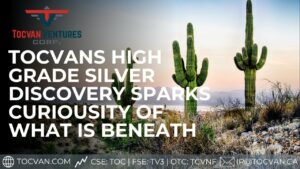Highlights:
Results of the first two diamond core holes confirm wide zones of very high grade silver mineralisation, including:
18.0m @ 655g/t Ag from 2.0m in MDPD-001
? 18.7m @ 530g/t Ag from 28.8m in MDPD-002
Good correlation of silver grades and mineralised widths between the diamond core holes and the twinned RC drill holes
Mineral resource RC drilling program proceeding with 9 holes completed
Azure Minerals Limited (ASX: AZS) (“Azure” or “the Company”) is pleased to advise that diamond drilling results have confirmed the spectacular high grade Mesa de Plata silver discovery, part of the Alacrán Project, located in the northern Mexican state of Sonora.

Figure 1: High grade silver mineralisation from diamond core hole MDPD-001
Assay results for the first two diamond core drill holes (MDPD-001 & 002) returned wide intercepts of high grade silver mineralisation similar to those achieved in the initial discovery RC drill holes (refer ASX release 16 September 2015). The diamond holes twinned two RC drill holes (LM-09 & 06 respectively) to provide a comparison between diamond core assay results versus RC assay results for mineral resource estimation purposes.
The width of the mineralised intersections and the average silver grade of those intercepts in the diamond holes correlate well with their respective twinned RC holes (see Table 1). This has confirmed that RC drilling will be a suitable method for determining the size and grade of the mineralised body, leading to the estimation of a mineral resource.
Table 1: Comparison of twinned holes – original RC holes versus follow-up core holes
Diamond core drill holes | RC drill holes | |
MDPD-001 | LM-09 | |
18.0m @ 655g/t Ag from 2.0m including: 10.5m @ 1,044g/t Ag from 2.0m | 18.0m @ 698g/t Ag from 1.5m including: 9.0m @ 1,235g/t Ag from 3.0m | |
40.6m @ 313g/t Ag from 0.0m |
39.0m @ 347g/t Ag from 1.5m | |
MDPD-002 | LM-06 | |
High Grade Zone |
18.7m @ 530g/t Ag from 28.85m |
21.0m @ 513g/t Ag from 28.5m |
Overall Mineralised Zone |
70.9m @ 176g/t Ag from 0.0m |
70.5m @ 197g/t Ag from 0.0m |
The diamond drilling has confirmed that the silver mineralisation at Mesa de Plata is hosted consistently throughout the vuggy silica and strongly silicified volcanic rocks, and that there is a strong relationship between the intensity of secondary silicification with high silver grades. The alteration, mineralogy and geochemistry indicate that the Mesa de Plata silver mineralisation is consistent with formation by a high sulphidation epithermal process.
The Mesa de Plata diamond drilling program comprising five holes has been completed. In addition to being used in the resource estimation process, core from these holes will also be used for mineralogical and metallurgical studies of the silver mineralisation.
The three remaining core holes are MDPD-03, which twinned LM-07, and MDPD-004 & 005 which were drilled into the northern part of the mineralised zone where rock chip sampling returned high grade silver mineralisation at surface. Further information from this latter part of the drilling program will be provided when results become available.

1 High Grade Zones use a 100g/t Ag lower grade cut-off and no top cut; with included zones using a 200g/t Ag lower grade cut-off and no top cut.
2 Overall Mineralised Zones use a 40g/t Ag lower grade cut-off and no top cut.
In addition to Mesa de Plata, Azure believes there is excellent potential for more significant accumulations of silver, gold and base metal mineralisation to be discovered elsewhere in this area. To this end, the Company is continuing with its regional exploration program in addition to the Mesa de Plata resource drill-out program.
RC DRILLING UPDATE
The RC drill program is designed to define the extent and grade of the silver mineralised system at Mesa de Plata. It comprises about 65 close-spaced vertical holes, each drilled to a depth of about 100m, located on an approximate 50m x 50m spacing. This is expected to be sufficient for a mineral resource to be estimated.
To date, nine holes for 810m have been completed on two section lines. Assay results will be released to the market as they become available.
-ENDS-
For further information, please contact:
or visit www.azureminerals.com.au
Information in this report that relates to Exploration Results is based on information compiled by Mr Tony Rovira, who is a Member of The Australasian Institute of Mining and Metallurgy. Mr Rovira is a full-time employee and Managing Director of Azure Minerals Limited. Mr Rovira has sufficient experience which is relevant to the styles of mineralisation and types of deposit under consideration and to the activity which he is undertaking to qualify as a Competent Person as defined in the 2012 Edition of the “Australasian Code for Reporting of Exploration Results, Mineral Resources and Ore Reserves”. Mr Rovira consents to the inclusion in the report of the matters based on his information in the form and context in which it appears.
Information in this report that relates to previously reported Exploration Results has been crossed- referenced in this report to the date that it was reported to ASX. Azure Minerals Limited confirms that it is not aware of any new information or data that materially affects information included in the relevant market announcement.
APPENDIX 1
TABLE 2: Drill hole information
HOLE No. | NORTH (mN) | EAST (mE) | ELEVATION (mASL) |
AZIMUTH |
DIP | TOTAL DEPTH |
LOCATON |
MDPD-001 | 3415411 | 571815 | 1572 | 000 | -90 | 126.2 |
Twinned holes |
LM-09 | 3415410 | 571817 | 1572 | 000 | -90 | 91.5 | |
MDPD-002 | 3415254 | 571861 | 1600 | 000 | -90 | 200.0 |
Twinned holes |
LM-06 | 3415254 | 571859 | 1601 | 000 | -90 | 90.0 | |
MDPD-003 | 3415175 | 571928 | 1596 | 000 | -90 | 200.0 |
Twinned holes |
LM-07 | 3415176 | 571930 | 1596 | 000 | -90 | 90.0 |
APPENDIX 2
Alacrán is located in the northern Mexican state of Sonora approximately 50km south of the USA border. The property covers 54km2 of highly prospective exploration ground in the middle of the Laramide Copper Province. This is one of North America’s most prolific copper- producing districts, extending from northern Mexico into the southern United States.
Alacrán lies in close proximity to several large copper mines, including being 15km from the world class, giant Cananea Copper Mine operated by Grupo Mexico. This is one of Mexico’s premier mining districts, with world class production of copper together with significant amounts of gold, silver and molybdenum.
There is excellent access to and within the property, via a sealed highway from Hermosillo, capital of the state of Sonora, and existing mine roads and ranch tracks. The nearby town of Cananea is a mining-friendly jurisdiction with experienced exploration and mining services, as well as physical infrastructure including roads, railway, airport, electrical power and water.
Commercial and artisanal mining occurred within the project area in the early 20th century, ending in 1913 due to the Mexican Revolution. Since that time, Alacrán has seen only limited exploration and its potential for hosting large porphyry copper deposits and smaller high grade precious and base metal deposits remains largely untested by modern exploration techniques.
The Anaconda Copper Mining Company explored the property intermittently from the 1930’s to the 1960’s. Data relating to this work is held in the Anaconda Geological Documents Collection, part of the American Heritage Centre in the University of Wyoming. Azure has visited the library and retrieved copies of numerous technical reports and maps.
Between the 1960’s and the early 1980’s, the Consejo de Recursos Minerales (Mexican Geological Survey) carried out occasional exploration programs, including drilling 6 holes at the Cerro Alacrán prospect in 1970 and undertaking geophysical surveys over the Palo Seco and La Morita prospects in 1981.
Grupo Mexico S.A.B.de C.V. (“Grupo Mexico”) then acquired the project and drilled 26 holes at Cerro Alacrán in the 1990’s. This drilling, which was restricted to an area of approximately 50 hectares, outlined a large body of near-surface, copper oxide and chalcocite (copper sulphide) mineralisation. The size, grade and the extent of this mineralised body is yet to be defined as a mineral resource to JORC standards.
Minera Teck S.A. de C.V. (“Teck”), a Mexican subsidiary of Canadian company Teck Resources Limited, acquired the property from Grupo Mexico in 2013 and undertook data compilation and limited surface exploration.
Azure Minerals acquired the rights to the project in December 2014 through its fully owned Mexican subsidiary Minera Piedra Azul S.A. de C.V.
Azure has signed an Agreement with Teck to acquire 100% of the property, subject to an underlying back-in right retained by Teck and a 2% NSR retained by Grupo Mexico. Teck is Canada’s largest diversified resource company. Grupo Mexico is Mexico’s largest and one of the world’s largest copper producers.
Original Article with Images: http://www.azureminerals.com.au/azs//assets/2015/11/1497004.pdf
























